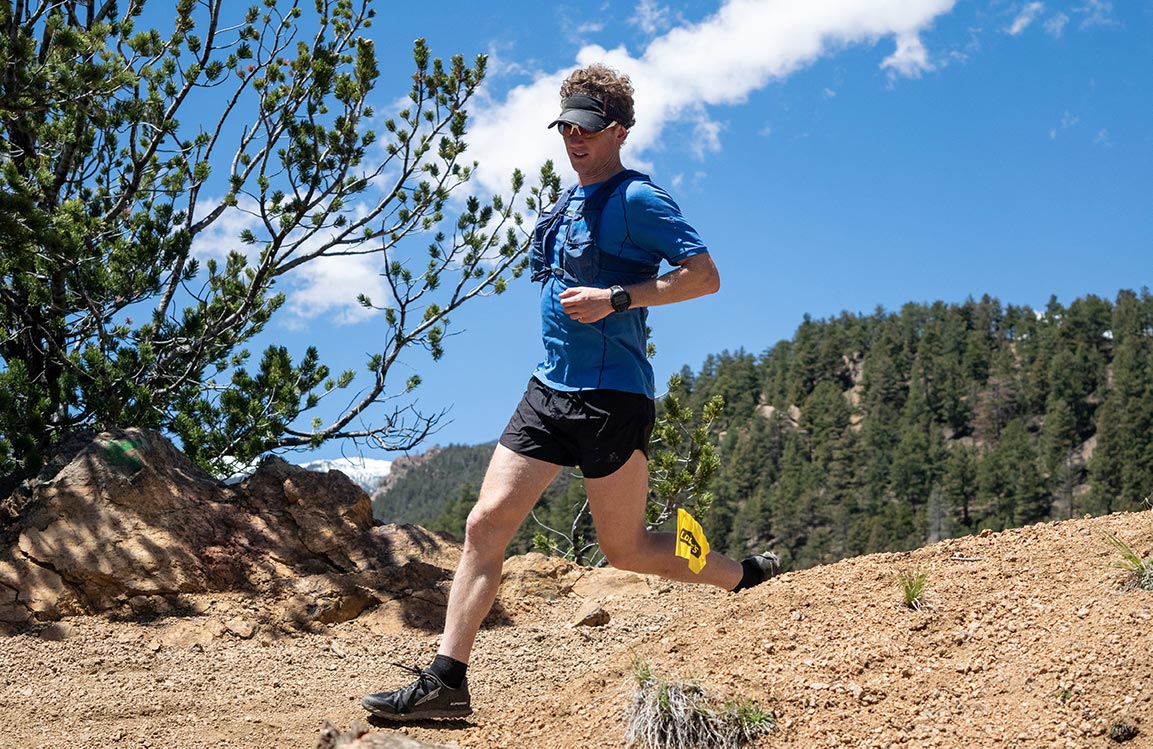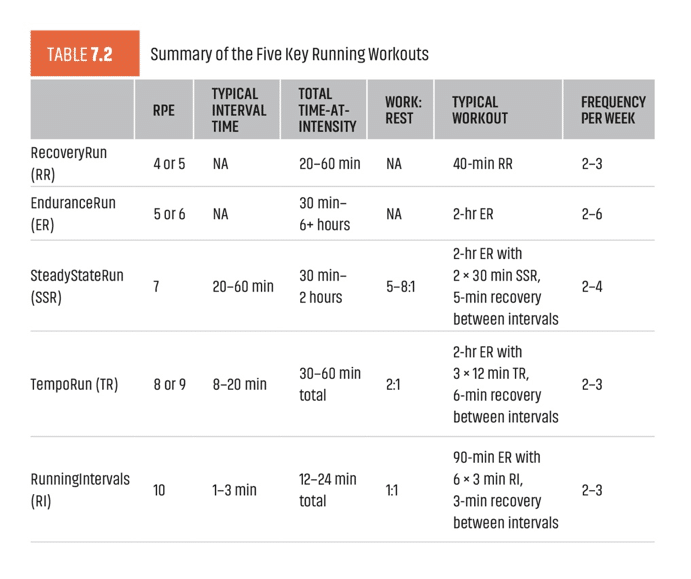
Short Intervals: Should Ultrarunners Jump on the 30-Second Interval Bandwagon?
By Jason Koop,
Head Coach of CTS Ultrarunning
If you want a quick fix or simple answer to all of your training needs, stop here. Go somewhere else and read another article as I’m not going to offer that up today. Every month or so, a new study comes out comparing one interval type to another. The resulting interval that ‘wins’ is lauded and then mimicked endlessly by athletes and coaches seeking some sort of holy grail of workouts. The most recent example came from the Scandinavian Journal of Medicine and Science in Sports where they compared effort matched (that’s a key word) short intervals of 30 sec with longer intervals of 5 minutes. The group found the shorter interval protocol (note I am adding the word protocol intentionally. Keep reading) to be superior to the long interval protocol in terms of improving power at 4 mmol lactate (a type of lactate threshold), the fraction of VO2max utilized at 4 mmol and average power during a 20 minute cycling test. By all accounts, the short interval group improved more than the long interval group. The question was, why? Why did this specific short interval protocol have superior effects compared to the effort matched long interval protocol. Having a self-professed affinity (maybe obsession) for these types of studies, I immediately passed it around (before it hit any of the mainstream outlets, I might add) to our ultrarunning coaching group and asked them ‘why was this happening?’. We came up with some good, and some not so good answers. Not surprisingly, the internet gurus pounced on the study as well, claiming the shorter intervals yielded everything from bigger gains to magical powers with accompanying analyses that vacillated reasonable to the ridiculous.
Are Short Intervals relevant for ultrarunners?
Although this particular study was on cyclists (cyclists are more commonly used in endurance studies because the intensity is easier to control and measure), the fact that it was effort matched is relevant for ultrarunners. What this means is that the research team designed two different workouts, one with shorter intervals and one with longer intervals and basically told the athletes ‘have at it’. No heart rates to hit, no paces to follow, just go as hard as you can for the entire set of intervals and let the chips fall where they may, similar to how you would pace a workout done on the trails.
Because of this effort-matched approach, the construction of the workout matters tremendously. Interval time, recovery time, and the total number of intervals will all essentially pigeonhole an athlete into a particular intensity and time at intensity for the workout. If you get the concoction of workout variables right, you can drive big adaptations. Get it wrong, and you can waste a lot of your hard work for minimal gain.
What this study really shows
Only very rarely can you pull a conclusion out of a magic hat from one singular study. And this study was certainly not rarified in this sense. All this study demonstrates is that one particular workout design is superior to another. To summarize the design, the short interval group performed three sets of 13 times 30‐second intervals separated by 15‐seconds recovery. After each set, the cyclists had a 3‐minute recovery period. The long interval group performed 4 × 5 minutes work intervals separated by 2.5‐minute recovery periods. It’s OK if you can’t do math in your head. I’ve summarized the workouts and the resulting power outputs in the table below.
| Short interval group | Long interval group | |
| Workout design | 3 sets of 13X30 seconds hard, 15 second easy. 3 min rest between sets | 4X5 min hard, 2.5 easy |
| Total time at intensity | 19.5 min | 20 min |
| Total recovery time | 15 min | 7.5 min |
| Average power output (work periods) | 441 W | 368 W |
Aside from being absurdly difficult to count (I mean come on, 13 is more fingers than you have to count with), the short interval protocol produced a higher power output than the long interval protocol, and not just by a small amount. I could say that this is due to the greater total amount of rest time as well the overall workout construction. In turn, that higher power output drove the superior adaptions. All that is true. But, the real reason that the short intervals are seemingly magic is that the long interval protocol was completely and totally ineffective. After the long interval intervention, the group of cyclists showed no meaningful improvements (and you could actually say they got worse in certain aspects). Maybe a better interpretation is ‘success by lack of failure’ for the short interval group? The reality is the long interval group suffered from both a terrible workout design (not enough time at intensity) as well as overall programmatic flaw (where ~40% of the overall training volume was reduced during the intervention). Simple as that. So simple, I might have fired a coach had he or she served that entire training protocol up to one of our athletes.
How to get it right, and avoid getting it wrong
Fortunately, sports scientists are as obsessed about these A vs. B (and C and D) studies as I am, and there’s a plethora of them to weed through. From Véronique Billat’s work in the 80’s and 90’s (fun fact, Billat won the famed Sierre-Zinal in 1982), Izumi Tabata’s renown 20-10 protocol, and more recently Stephen Sieler’s polarized training model, you can have your pick from which research to delve into. If you take into account all of the research, what will percolate to the top is a mixture of total work time and work to rest ratio that can make you faster. What you will also find is that certain combinations are ineffective (see the workout of 4X 5 min with 2.5 min recovery above), particularly for highly trained athletes.
The winning combinations I have summarized in the table below, adapted from ‘Training Essentials for Ultrarunning’
► Free Ultrarunning Training Assessment Quiz
Take our free 2-minute quiz to discover how effective your training is and get recommendations for how you can improve.

Enjoying This Article? Get More Free Running Training Tips
Get our coaches' best training advice, delivered straight to your inbox weekly.
To keep interval training simple, consider that all intervals are completed at the highest pace you can sustain for the entire set of intervals. The combination of interval number, length and rest between intervals determines the target, not the other way around. The higher the intensity, the less time you can sustain it. This shouldn’t be news to anyone. If you’re pacing yourself at the highest intensity you can sustain for three minutes, it’s going to be a very hard effort. It’s no surprise to me that the long interval group in the aforementioned paper showed little or no improvement. They were doomed from the start simply from the construction.
What about intervals less than one minute?
Intervals less than one minute have their time and place with the right construction. As Chris outlined in his blog on Saturday, short intervals are good for athletes’ physical tools and mental skills. Are they ultimately superior in every way, shape and form to their longer interval counterparts? Certainly not. You can easily construct a workout similar to the short interval group above and see some benefit. This is provided that you can count to thirteen, three different times while hammering down the trails. Seriously, can you actually do that? I have athletes who can’t count to five intervals. Anyway, complete that short interval workout several times over a few weeks and you will realize benefits from it provided the rest of your training is in line. But, don’t think it’s superior to any other well constructed interval plan.
Post Script- I would like to offer sincere condolences to the family of recently deceased Gunnar Borg, who pioneered the widely utilized Borg Rating of Perceived Exertion scale. Utilized by athletes, coaches, doctors and the health and fitness community as a whole, we are all indebted to Gunnar Borg for his work in the field.


Comments 13
Vern, I think it would be more useful to look at studies that use the same percentage of race pace. Comparing a bunch of different workouts that are done at 5K race pace would be very interesting. For example, which of these 5k-paced workouts elicits greatest Improvement: 60 x 30 sec on/30 sec off, 30 x 1:00 on/1:00 off, 15 x 2:00 on/2:00 off, 10 x 3:00 on, 3:00 off? Or, could they all be used, maybe twice a week for three weeks each, progressing from the first to the second to the third to the fourth in an effort to improve cruising speed? The fact that the workouts in the article were effort-matched made them very hard to compare in my opinion.
Pingback: Ultramarathon Daily News | Thurs, Feb 13 - Yeovil Marathon
Pingback: 3 Steps to Make the Most of Your 2020 Ultramarathon Training - Jason Koop
Pingback: Ultramarathon Daily News | Thurs, Feb 13 | Ultrarunnerpodcast.com
Short intervals (efforts of 3 min and less) really should be the main stay of a runners diet, intensity-wise. 1st of all, data derived from a study of cyclist isn’t going to accurately correlate to runners. Why? Cuz the act of efficient running demands adequate neuromuscular training in order to have good running economy. In running vs cycling, it takes years upon years to develop efficient running form whereas a cyclist can develop prime neuromuscular form in 6-12 months, cuz cyclist are riding a machine. Runners are the machine. Cycling is still totally cool though! But cuz of impact forces runners are capped in terms of running hrs per week. A cyclist can do 20+ with no prob. So what’s the safest most efficient way for runners to get fast and all most always somewhat close to a peak? It’s by doing a boatload of Z2 and some strides. Like with a ratio of 90-95% Z2 and 5-10% strides. Then throw in a 30 min LT run, some 2:1 intervals and some course specific stuff and the result is mega fitness that has been fostered in a really safe and sustainable way.
Nice article. I did read Hutchinson’s Outside article last week and decided to try my own version of the 30-15 workout, although I did 14 reps on the third set to make an even 40 reps for the three sets 🙂 I did the workout on a treadmill with the grade at 15% and pace 8:00/mile. I took a 2 minute rest after each set (forgetting the study had mentioned 3 minutes). The grade and pace was more of a guess in terms of what would elicit a strong perceived exertion but it turned out to be about right. By the final reps in the third set, I was working hard. I think part of the beauty of this shorter interval/rest is that your body has to scurry and find a way to deal with the lactic acid (aka pain) without much relief. It was fun to throw something new into my workout mix at the very least.
Sorry, I’m still confused as to what is wrong with the 5 minute intervals.
Jono,
Yes, 4X5 w. 2.5 min recovery is not enough time at a high enough intensity to elicit an adaptation for that level of athlete (clearly).
There are a lot of interval structures studied, but I think you are referring to this paper-
https://www.researchgate.net/publication/51543724_Adaptations_to_aerobic_interval_training_Interactive_effects_of_exercise_intensity_and_total_work_duration
The 30-30 structure you are referring to are typically called ‘float’ intervals. I generally don’t like to convolute interval structure all that much by running at a higher intensity rest. You run hard, then you recover. repeat. I’d rather manipulate the HR drop with the length of the recovery interval , not the intensity unless there is a REALLY specific reason (usually stragety or the way the race lays out)
Great article but I am confused after listening and reading to Coach David Roche that seems to swear about short intervals aka Strides.
He says that it increases highly economy, so wouldn’t that justify the need for those short intervals ?
https://www.strava.com/athletes/1733803/posts/2951648
Federic,
There are no magic workouts! Strides don’t improve running economy any more than any other hard workouts. They have their time and place, but if you are doing them predominately for economy benefits, there are better ways.
I see, thanks, now that’d be interesting that you have D. Roche on your KoopCast to talk about your views and opinion differences on training 🙂
As an aside, I found a great app for counting intervals and rest periods. It’s Tabata Timer for my Android. It is, after a quick search, available for all the iOS devices, including the Apple Watch.
It’s a bit fiddly, but I was able to quit doing time math (my skills evaporate after about 8m 07s) and I use it not only for interval workouts but on long endurance runs to remind me to hydrate and eat!
Just wanted to clarify – were you saying the structure of the long intervals was flawed because the work to rest ratio was the wrong combination?
I thought Seilers work looked at intervals of 4x 4minutes with 2mins rest?
And building from the 30sec-15sec intervals – what would you think of a similar interval of 8–10min of 30 seconds on, 30 seconds off. The “on time” at around 92–95 percent of your max HR. Let HR drop only about 5 bpm during the “off” interval? Would certainly be easier to count haha!